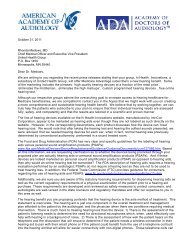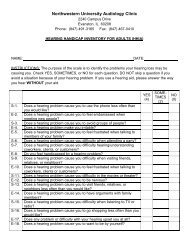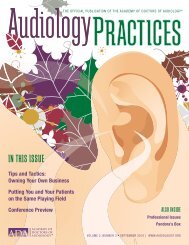IN THIS ISSUE - Academy of Dispensing Audiologists
IN THIS ISSUE - Academy of Dispensing Audiologists
IN THIS ISSUE - Academy of Dispensing Audiologists
Create successful ePaper yourself
Turn your PDF publications into a flip-book with our unique Google optimized e-Paper software.
ass boost induced low frequency noise the user may have<br />
experienced with traditional directional processing. Conversely,<br />
if the average is greater than 40 dB, the frequency is set<br />
lower as low frequency noise would be less audible to this user.<br />
In summary, split-band directionality is a method in which<br />
omnidirectional processing is applied to the low frequencies<br />
and directional processing is applied to the high frequencies<br />
and then the signals are mixed. This type <strong>of</strong> processing allows<br />
for better sound quality while also preserving localization cues<br />
when listening in the directional hearing aid setting and still<br />
delivers good directional SNR improvement to the end users.<br />
Asymmetrical Directionality<br />
problem solved: directionality creates “tunnel”<br />
hearing, cutting the user <strong>of</strong>f from signals<br />
they may want to attend to.<br />
As stated earlier, directional microphones that were introduced<br />
in the early 2000s could be switched from omnidirectional<br />
to directional settings manually by the hearing-aid user.<br />
In 2004, Cord and colleagues published a study that indicated<br />
that many users (30%) did not switch between the settings.<br />
The study stated that users <strong>of</strong>ten did not know when to switch<br />
and/or did not want to do this manual switching in everyday<br />
life. To overcome this manual switching problem, automatic<br />
switching hearing aids where introduced where the hearing<br />
aid automatically changes from an omnidirectional setting to<br />
a directional setting depending on the environment. These<br />
types <strong>of</strong> switching algorithms depend on environmental classification<br />
systems which analyze the acoustic scene and make<br />
a decision about which microphone mode would be most<br />
beneficial. Thus these systems are limited by the accuracy<br />
<strong>of</strong> the classification system and have no ability to determine<br />
the hearing aid user’s intent in complex listening situations.<br />
One field trial <strong>of</strong> automatic switching systems (Dittberner, A.,<br />
personal communication), showed that the switching systems<br />
were in the directional settings from 5 to 17% <strong>of</strong> the time. The<br />
results <strong>of</strong> Walden (2004) suggest that the average user is in an<br />
environment in which a directional-microphone setting can<br />
be beneficial approximately 33% <strong>of</strong> the time. Thus, the switching<br />
algorithms currently used in hearing aids can be too<br />
conservative with the end result being that the user is not in<br />
the directional setting when it could be beneficial. Additionally,<br />
the Cord et al. (2002) study showed that although many<br />
patients do not use their manual switching option, those that<br />
do prefer the manual mode rather than rely on the decisions<br />
<strong>of</strong> automatic switching algorithms. The reason for this might<br />
be that the automatic switching algorithms are not switching<br />
effectively and/or appropriately.<br />
The standard way to use directional processing in a bilateral<br />
hearing aid fitting has been to apply directionality simultaneously<br />
in both hearing aids <strong>of</strong> a binaural fitting. In other<br />
words, both hearing aids are in the directional setting in a<br />
noisy environment. Another way to use directional processing<br />
is to keep one hearing aid set to omnidirectional and the<br />
other hearing aid set to directional. This seemingly unconventional<br />
way to apply directional processing can provide a<br />
better listening experience for users <strong>of</strong> hearing aids and overcomes<br />
the limitations <strong>of</strong> directional systems discussed above.<br />
Specifically, an asymmetric fitting can overcome the lack <strong>of</strong><br />
use <strong>of</strong> manual systems and the reliance on environmental<br />
classification systems. An additional benefit is that it does not<br />
cut a listener <strong>of</strong>f from their environment as wearing two hearing<br />
aids in directional settings can do. The user can choose<br />
to attend to whatever signal they may be interested in hearing.<br />
The key to asymmetrical directionality is to understand<br />
that one hearing aid in the directional setting and one in the<br />
omnidirectional setting provides the same SNR benefit as<br />
using two hearing aids set in the directional settings. Several<br />
studies have verified this including Bentler et al. (2004), Cord<br />
et al. (2007), and Mackenzie and Lutman (2005). Using hearing<br />
aids set asymmetrically comes with the added benefit <strong>of</strong><br />
maintaining maximum auditory awareness for sounds arising<br />
from any direction. It was noted in this article that Walden et<br />
al. (2004) determined that directional microphones work the<br />
best when the signal <strong>of</strong> interest is close to and in front <strong>of</strong> the<br />
listener and the noise is spatially separated from the signal<br />
<strong>of</strong> interest. In the real-world, there are many environments<br />
where these conditions would not be true in a noisy environment.<br />
In fact, the signal <strong>of</strong> interest in real life is not always in<br />
front <strong>of</strong> the listener. This signal can be at any location. There<br />
can also be multiple signals <strong>of</strong> interest in an environment. For<br />
example, when a hearing aid user is sitting around a table with<br />
many speakers the directional microphone settings might cut<br />
a listener <strong>of</strong>f from what they want to ear. If a listener is using<br />
two hearing aids set to directional settings they can be cut <strong>of</strong>f<br />
from their environment making it difficult to even be aware<br />
<strong>of</strong> sounds from other directions.<br />
Finally, Cord et al. (2007) found improved ease <strong>of</strong> listening<br />
for asymmetric directional fittings as compared to bilateral<br />
directional fittings. Users do not feel as isolated from sounds<br />
originating from the sides and rear due to the environmental<br />
sound cues from the omnidirectional processing that is<br />
always available to them.<br />
AUDIOLOGY PRACTICES n VOL. 3, NO. 2 17










